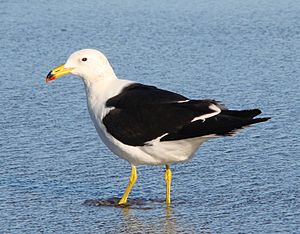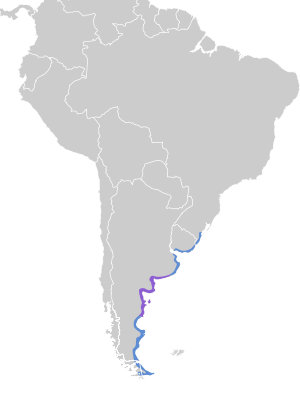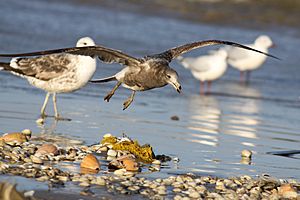Olrog's gull facts for kids
Quick facts for kids Olrog's gull |
|
|---|---|
 |
|
| Conservation status | |
| Scientific classification | |
 |
The Olrog's gull (its scientific name is Larus atlanticus) is a type of gull. You can find it along the Atlantic coast in southern Brazil, Uruguay, and northern Argentina. It used to be thought of as a smaller group of the very similar Belcher's gull.
This is a big gull. It has a black back and wings. Its head and belly are white. Its tail is white with a black stripe. Its beak is yellow with a red and black tip. When they are not breeding, adult gulls have a dark head and a white ring around their eyes. This gull is named after Claes Christian Olrog, a scientist from Sweden and Argentina. It only breeds in a few places. Because it is losing its home, the IUCN says it is "near threatened". This means it could become endangered soon.
Contents
What Olrog's Gulls Look Like
Olrog's gull is a large bird. Its head, neck, and belly are white. Its back and wings are black. The very edge of its wings is white. Its tail is white with a wide black stripe.
The beak is yellow. It has a black band and a red tip. Its eyes are brown. They have a red ring around them. The legs and feet are a dull yellow color.
These gulls are about 50 to 60 centimeters (20 to 24 inches) long. Their wings can spread out 130 to 140 centimeters (51 to 55 inches) wide. Male gulls are a little bigger than females. Young gulls have black heads and brownish feathers.
Where Olrog's Gulls Live
Olrog's gull lives along the Atlantic coast. You can find them in Argentina, Uruguay, and southern Brazil. They breed in only a few places. These places are between 38.49° and 45.11° South. About two-thirds of these spots are in the Bahia Blanca River area.
They build their nests on the ground. They choose low islands and small pieces of land. These spots are just above the high-water mark. When they are not breeding, you can see them in other places. They like rocky coasts, harbors, and beaches. They also visit coastal lagoons, salty water areas, and river mouths.
How Olrog's Gulls Behave
What Olrog's Gulls Eat
During the time they are breeding, Olrog's gulls mostly eat crabs. They pick up crabs from the shore when the water is low. They also find them on the seabed. They can walk or swim to get food. Sometimes, they dip their heads under shallow water. Because they eat so many crabs, people in their home country call them gaviota cangrejera. This means "crab-eater gull".
At other times of the year, they eat other things. They add clams and sea worms to their diet. They also eat insects, snails, and fish. Sometimes, they eat fish waste. These birds even visit places where sewage goes and trash dumps to find food.
Reproduction and Life Cycle
Olrog's gulls start breeding in September and October. They stay with one partner for life. They build their nests close together in large groups. The nest is made on rock, sand, or small stones. They usually line it with plants. Sometimes, they use seaweed, feathers, shells, or bones.
Female gulls lay two or three eggs. The eggs are olive-brown with brown spots. The eggs are kept warm for about 30 days. This is called incubation. The young birds learn to fly between November and January. The exact time depends on where the colony is located.
See also
 In Spanish: Gaviota cangrejera para niños
In Spanish: Gaviota cangrejera para niños



